Over the Siege
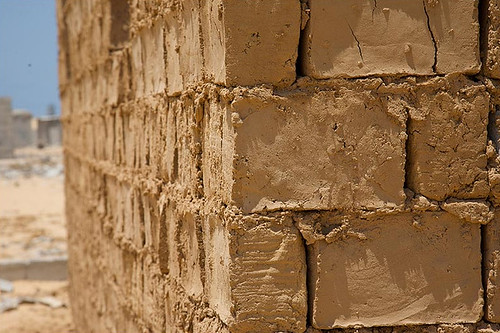
[Image: Gaza's new mud homes, BBC]
This is hardly breaking news by now but needs to be mentioned here as we try to return to our own temporarily abandoned excavations at Subtopes. Forgive the two month silence; breaks were needed to tend to other business, and for some exciting reasons that I will be relaying shortly. For now, we’re rolling up our sleeves and activating the bellows to our air hoses again – it’s time to surface with our tunnel gear and get Subtopia sinking down below again. When we say surface that’s really just code for digging in again.
As you may or may not know at this point the recent Israeli annihilation of Gaza which commenced just two days after Christmas of 2008 and carried on for weeks crossing over the new year, left an estimated 400,000 Gazans without running water, and at one point 800,000 without working electricity and lights, while roughly 5000 homes were critically damaged if not totally destroyed, casting tens of thousands into homelessness in the decimated contours of Gaza’s rubbled craters that suddenly supplanted their homes, industries, and neighborhoods like massive footprints of airborne berserkers that never actually touched ground. It was one of the quickest and worst plunges into manmade disaster the world has witnessed in some time, and the density of the area certainly didn’t help to soften Israel’s blows. It was a lesson in manufacturing scaled abomination.

[Image: Photo: Abid Katib/Getty Images]
I am not going to recount all the details of the conflict where close to two thousand Gazans were reportedly killed, of which we read “more than 43% of deaths and injuries were women and children”, and where ancient cultural antiquities were pummeled shamelessly despite international law that prohibits attacks on cultural monuments and artifacts. Instead, I will offer you this brief assessment put forth after the week of January 15-22 by the Palestinian Centre for Human Rights who was tracking the progressing damage states week by week:
The vast majority of casualties were civilians. "Entire features of many areas have disappeared, and civilian infrastructure services have completely collapsed." Other destruction included:
-- hospitals, ambulances, civil defense and private vehicles, and relief services damaged or destroyed;
-- thousands of homes and whole neighborhoods damaged or destroyed as well as -
-- roads, bridges, power installations, sewage facilities, water wells, and other infrastructure;
-- 28 public civilian facilities;
-- ministry, municipality and other government buildings; the parliament building;
-- UN sanctuaries;
-- commercial buildings;
-- 121 industrial and commercial workshops destroyed; at least 200 others damaged;
-- fishing boats and harbors;
-- 21 private projects, including cafeterias, wedding halls, tourist resorts and hotels;
-- 30 mosques completely destroyed; 15 others damaged;
-- five concrete factories;
-- 60 police stations;
-- five media buildings and two health ones completely destroyed;
-- 29 educational institutions completely or partly destroyed; and
-- thousands of dunams of agricultural land razed.
And that probably only covers a portion of the footprint. Needless to say, Gaza was pretty much brutally battered. Disproportionately so? -- (as in, the attack was a non-justifiable over-response to the constant volley of Hamas rockets) -- well, just about everyone in the world except the IDF seems to think so. But, no one can say this wans’t out of character, either.

[Image: Palestinians moved through the rubble of a house destroyed by an Israeli airstrike in Gaza City. Israeli troops edged closer to the heart of Gaza City on the 19th day of the Gaza war. Photo: Mohammed Salem/Reuters]
So, given this as the starting point for this post, next thing you ought to know is that reconstruction efforts have been utterly stymied, by various political forces naturally but largely due to Israel’s refusal to allow the most basic of needed supplies like concrete, steel, and even glass to enter into the strip at all claiming those materials would only serve Hamas’ efforts to rekindle its armament and offensive capabilities. Egypt has fallen more lockstep in line with Israel by enforcing its borders while the US has thrown in some tunnel detection technology for testing.
But, there is a lot more to the siege than that and a lot more Israel is doing to effectively strangle Gaza -- but, again, I will leave you to your own devices there, too.
4 billion dollars were initially pledged by the international community to help rebuilding efforts, but the money has since sat frozen, unspent. As long as Hamas would be responsible for the financial management of those funds, no one feels comfortable actually releasing them.
It’s a mess of the most urban dismal kind, really. And there the innocent people of Gaza sit waiting, choking, assembling for some signs of hope to spring from their wasteland.
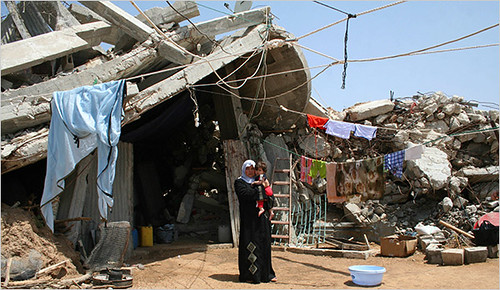
[Image: Ashraf Amra for The New York Times]
Yet the people of Gaza, fed up with just about everyone (including Hamas) have begun to rebuild on their own out of those piles of jagged ashes. And, ironically enough, the material they’re using – good old fashioned mud – is coming from perhaps the most contentious of infrastructural conduits sustaining Gaza: the underground cross-border “smuggler tunnels.”
Though, I’m hesitant to call them smuggler tunnels myself because “smuggler” seems to do the proud and resourceful Palestinians a gross derogative disservice in my view; to attach a stigma like that to these trade routes which for all intents and purposes are the only linkages to the outside world keeping them alive, just seems like more dangerous linguistic othering of the Palestinians than any really useful reference at this stage. I mean, when you’re forced to smuggle, by sheer necessity of survival, due to forces completely outside of your own control, when the power to decide your own destiny has been taken from you (as a nation), can it really be called smuggling anymore? Further, can smuggling really be considered an illegal or illicit act in this case? The very use of the word here to me seems to play into the feral-ization, if you will, of the Gazan people – it helps portray them as uncivilized subversives and criminal traders.
I call them, simply – Gaza’s border tunnels.

Regardless, these tunnels now all the more seem to be proving their true worth and resource, perhaps even evidencing further dimensions of some of their political innocence. As you may remember, the tunnels were heavily targeted by the IDF because many were suspected of being used to smuggle arms for Hamas across the Egyptian border. While some were (and still are, for all we know) used for weapons, many if not most by that point were really only serving as the economic lifelines of a people who had no other means for accessing the bare necessities of life, since both Israel and Egypt control all of Gaza’s borders. The strip is literally severed and somewhat de-sovereignated by the Israeli siege, and the tunnels represent the frontier of Gaza’s fight for geo-economic autonomy.
Yet, how the IDF chose to target and destroy (or attempt to destroy) those tunnels and to what degree the intelligence and effectiveness of those bombing campaigns were accurate, we will never fully know. Yet, the tunnel trade is still largely in tact, also to the extent that it is really almost a myth as to how many tunnels still operate (but think somewhere in the hundreds), and in some cases are even more fortified than ever before. For the most part they are still delivering the same harmless goods they always did: livestock, laundry detergents, cigarettes, basic fuels, toys, and chocolates.
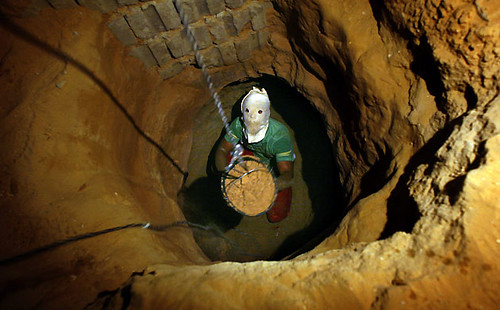
[Image: Photograph: Kevin Frayer/AP]
The tunnels obviously fascinate Subtopia for several reasons: their epic versatility and historic resilience as a sort of timeless script of terrestrial fossils inscribed into the earth that has served humanity as a great epochal crutch many times, but in this case also because of the specific ambiguous nature of target-production they presented for the IDF. On one hand, the tunnels might be considered legitimate military targets (i.e. weapons smuggling tunnels), while on the other the tunnels (which had just prior to Israel’s attack been legally sanctioned by Hamas as national infrastructure to be regulated through taxation and labor laws) – were civilized and had nothing to do with weapons smuggling, militant armoring, or any other such violence-towards-Israel associations. Hence, the ambiguity of a dual-use target.
However, I always thought this was a perfectly designed outcome of the Israeli siege that would in the end ensure a convenient excuse to destroy the tunnels. Basically, by forcing the Gazan economy underground the IDF made a suspicious target of the entire tunnel trade infrastructure. By tunnelizing Gaza’s economic corridors they forced them into a blurry indistinguishable context shared with the weapons trade, thereby making it much easier to get away with annihilating all of the tunnels rather than singling out the military tunnels, whether they were legit targets or not, and ultimately attacking the larger infrastructure in order to further the effects of the siege.
It no longer even seemed to be about deciding on what is or is not a legal target anymore. The IDF in some way essentially preemptively produced their own targets in Gaza by virtue of the effects of the siege. Can targetting the tunnels be considered an act of urbicide?
Yet, as we said, not only did many of the tunnels survive those overwhelming bombing barrages (bombs which still fall on them today), but many have found their routes even deeper underground now able to avoid conventional detection technology, and resist fatal damage from the blasts. More importantly, the tunnels themselves have yielded tons and tons of valuable mud that have spurred new hopes in rebuilding efforts despite the siege, the atrocious geopolitics, and Hamas’ own barriers in this process.
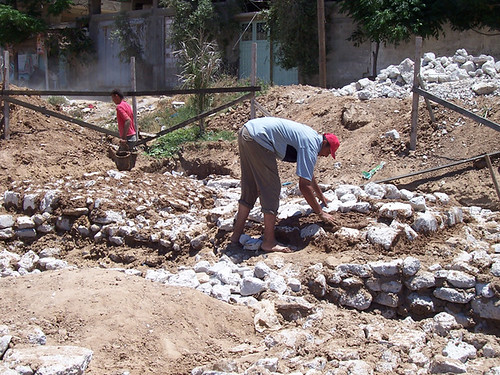
[Image: Construction workers on a 5,000sqm building site haul buckets of clay under the blistering sun to mould large cement blocks to be used in building a school for handicapped children in Gaza City, © Erica Silverman/IRIN]
Hamas is actually supporting the mud-brick housing movement and has pledged money and assembled a special engineering committee to investigate a pilot project that will test a multistory school to determine just how safe and plausible building more widespread with mud brick can be. Of course, all of this has spawned a new temporary economy in tunnel mud removal and brick manufacturing, and the engineering itself is quite antiquated but none the more outdated. They’re using combinations of mud, sand, salt, and straw, and in some cases rubble to forge bricks and build basic homes. Some have already been said to have withstood elements of winter rains and harsh summer sun.
And so, the ingenuity of the Gazan people goes on!

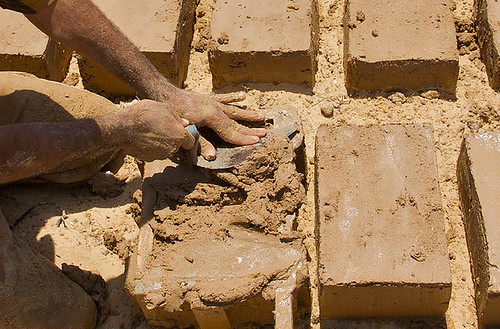
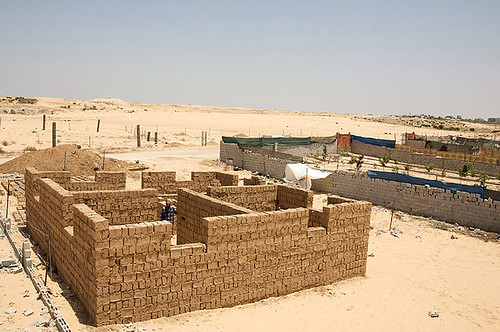
[Image: Gaza's new mud homes, BBC]
With these story lines it’s all the more interesting to think of this housing not just as autonomous innovative refugee mud brick sheltering (something AFH could certainly appreciate), but as extensions of the tunnels themselves, as architectural by-products, or even another form of economic tunnel products, if you will. It’s fascinating to me that the tunnels even in their destroyed state continue to assist the Gazan economy. Refuge spaces spawning from rooted industries below the radar to provide some of the only protective roofing in the area.
It’s almost as if the tunnels had been turned inside out, sort of poetically unraveled overland as a result of the Israeli assaults, and now offer the dual benefit of both relief housing while also keeping the essential corridors of underground commerce alive.
In some ways it’s just good old-fashioned poetic justice bound with some gritty irony.
And for all Israel does to try and crush them, to expose and bleed them further to surface, their efforts have only shown to have driven the economic tunnels further underground while exposing how the tunnels can also serve the Gazan population in a completely humanitarian way, by being reinvented right there on the Gaza landscape for all to see in the form of shelter; the bowels of the tunnels regurgitated from the earth, reconfigured into neat stacks of the most needed thing of all – new housing, schools, mosques, new spaces of rebound. And so, the epic persistence and quasi-architectural resistance of the tunnels once again yields their amazing blueprints as uprooted spaces edited into fresh new infrastructure now in plain view.
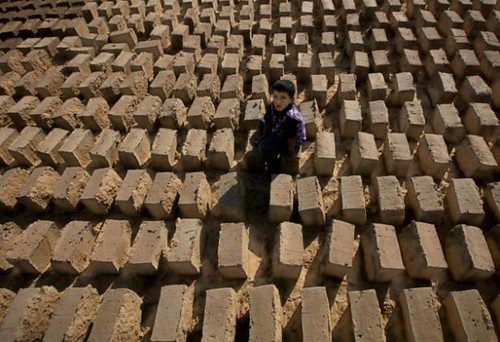
[Image: A Palestinian boy sits on a row of adobe bricks in the town of Rafah, the centre of Gaza's mud industry (Mud, mud, glorious mud. Nothing quite like it for beating the Israeli blockade) / The Independent/EPA]
You might say, the tunnels in this "reused" regard have positioned the Palestinians in a small sense over the siege, not just under it, as the regular news headlines like to read when referring to the tunnels: Under the Siege.

[Image: Palestinians took boxes out of a building hit in an Israeli airstrike in the Rafah refugee camp. The Israeli military said its planes struck some 70 targets in Rafah overnight. Photo: Eyad Baba/Associated Press]
However, it begins to make us think and worry (maybe a bit paranoiacally). It is in other ways still a tragedy that the Gazans are being made to inhabit the tunnels (it’s one thing to force their economy there, but now their spaces of existence too?), only instead of actually crawling down into them where many die daily laboring they are living inside them reconstituted above ground.
One wonders by their very physical connection to the tunnels, will the IDF one day decide these housing structures are a threat, too? Is this merely falling into the strategy of anther IDF production of a Palestinian dual-use target? Not that the IDF ever needed any more justification than they themselves (and only themselves) have been willing to put forth in order to demolish Palestinian homes and structures, but I wouldn’t put it past them to claim the new mud-brick structures are somehow a threat to Israeli existence by virtue they’ve been forged by material from smuggler tunnels.
Come to think of it, why would they stop there: perhaps the IDF will begin to claim that every Palestinian is a target for simply consuming and living off of the products that come through the tunnels, as a way to biopolitically engineer the entire Gazan population as a wholesale terrorist suspect having literally digested smuggled goods.
OK, that might be a little extreme but then again the whole context is routinely terrorized by political and militaristic extremities. I’m not trying to fan the reality, really, but am very curious about how the ambiguities of what constitutes a legal military target and a dual-use target are analyzed and in some instances prefabricated. The notion of turning something into a target rather than deciding upon the legality of a target based on an international legal frameworks is nothing but precedented by the development of war, which has always been conducted not only on what a hostile threat has presented intrinsically but based on how militaries decide to view and classify targets by their own judgment and strategy.
I mean, it’s probably much more simple than that: war wouldn’t exist without targets. And targets don’t just materialize out of thin air. They’re projected as much as they present themselves within the logic of war. But, despite advances in technology and precision grade weaponry, the target seems to be all the more confused these days on the battlefield, shrouded in urban counterinsurgency sure but maybe also purposefully and politically/categorically confused as well, and is often just easily written off as collateral damage. Just look at the ongoing spate of civilian casualties in the Afghan/Pak region brought by U.S. drones.
A dangerous parallel seems to be developing: all the precision targeting weapons in the world don’t make much difference when the targets themselves become increasingly confused, and I don’t think the perfection of such weapons will be the tools to disentangle the ambiguous terrain of the dual-use target debate but may perhaps only further obscure the controversy. Which came first: confused targets or more precise weapons? Does it even matter? Both are being produced in their own ways, maybe even in some sort of unison. Of course, certain weapons respond better to a given target. To make a weapon perform at its own ideal, one might even design the target to accommodate the weapon. All of which is a very circuitous way of asking, how might the War On Terror be producing its own targets, to fit the scale of its military control?
Further Reading
PROJECT FOR GAZA / PROJET POUR GAZA / Arch Peace
Palestinian farmers use permaculture to challenge occupation / ei
Gaza: The destitute and the forgotten (Video) / Guardian







6 Comments:
A similar scenario could be possible along the U.S./Mexico border. The Adobe Alliance, a non-profit organization that has imported the theories and techniques of the Egyptian architect Hassan Fathy, teaches Nubian mud brick vault construction on the border near Presido, Texas and Ojinaga, Mexico. A border levee-wall is scheduled for construction in Presido.
Welcome back Subtopia, fantastic post - architecture is always in some form a manifest of earth's products (like a meal is the product of the chef and the ingredients) , but never so nakedly as in the gaza examples you've posted.
I was particularly struck by the image of the Palestinian boy amid the brick: a field of clay that looks like nothing so much as Berlin's Monument to the Murdered Jews of Europe.
DG
Hey Bryan,
Good to see you back
Kudos to you! There are so few who care, especially among architects.
I couldn't find a contact email for you Bryan, but I just saw this and it reminded me of your Gaza piece. I thought you'd be interested:
Egyptians build steel Gaza wall
http://news.bbc.co.uk/1/hi/world/middle_east/8405020.stm
thx nate! appreciate that a lot. saw this in Haaretz yesterday, but not yet the BBC article.
Thanks. by the way. subtopia.blog at gmail is what you were looking for. contact me any time.
Post a Comment
<< Home